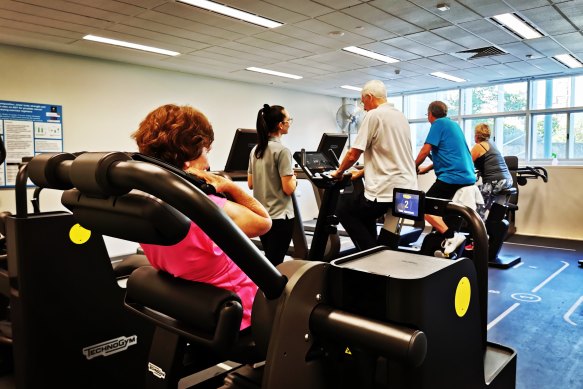Exercise can help patients avoid deadly heart damage from life-saving cancer treatments
Hospitals are rolling out fitness classes and prescribing exercise to patients to prevent a potentially deadly side-effect of cancer treatment on their hearts.
Associate professor Erin Howden from the Baker Heart and Diabetes Institute said heart damage or “cardiotoxicity” was a serious and unintended risk of some cancer treatments.

Nick Lyall has been cancer-free for five years. He says he’s fitter than ever and can keep up with daughter Abby, 7.Credit: Simon Schluter
These treatments include chemotherapy drugs containing anthracycline, targeted therapies, radiation to the chest and bone-marrow transplants.
“Putting people to bed also leads to a loss of fitness and cardiac function,” she added.
It’s estimated that up to 20 per cent of cancer patients who receive cardiotoxicity-causing treatments as adults may experience heart damage, and between 7 and 10 per cent of this cohort will experience heart failure.
Research co-authored by Howden, published in the journal Circulation this week, found that exercise and reduced sedentary time during and following bone-marrow transplants, preserved patients’ cardiorespiratory fitness and exercise cardiac function.

Exercise before, during and after cancer treatment has health and wellness benefits.
“It prevented the declines we saw with patients who just received usual care,” she said. “Essentially, the intervention prevented around two to five years of cardiovascular ageing.”
The patients involved in the study were split into two groups: one group received standard clinical treatments, while the other group were prescribed fitness activities with an exercise physiologist three times a week in their hospital room and then for 12 weeks after discharge at the Baker Institute’s gym.
“A lot of what is happening to cancer patients is out of their control,” Howden said. “This was something they could control...they really found the program beneficial.”
Howden said even small amounts of physical activity, such as a short walk or gentle stretches, can be beneficial to reduce side-effects and improve quality of life.
Nick Lyall didn’t expect to see a spin bike in his hospital room as he battled acute myeloid leukemia in 2019.
He’d been diagnosed with the blood cancer after experiencing a sore back and a lack of energy, which he had initially put down to a gym or football injury and running around after a young child while working full-time.
It turned out cancerous cells were growing on a nerve near his spine. The 30-year-old endured four rounds of intense chemotherapy and then a bone-marrow transplant.
He signed up to the Baker Heart and Diabetes Institute study because he wanted to become active again after lying in bed for the best part of six months.
He started off slow from his room at The Alfred. ” It took me 10 minutes to ride 500 metres on the spin bike,” he recalled. “Before the cancer I would’ve been able to do it in under 30 seconds.”
Lyall improved over time, under the supervision of an exercise physiologist, and began incorporating strength exercises and then walks through the ward.
The exercise program challenged his perceptions of healing.
“Recovery is often associated with rest but this active recovery was really good for me,” he said. “It gave me a sense that I was doing something to speed up my recovery.”
Lyall has now been cancer-free for five years and said he’s fitter than ever. He’s playing football, hitting the gym and running around local parks and playgrounds with his daughter Abby, 7.
At Peter Mac, many patients are prescribed exercise before, during and after their cancer treatment. They receive face-to-face or virtual exercise classes, a home fitness program and have access to the hospital’s gym.
“Exercise is an important arm of our therapy for cancerdaily plan patients,” said Peter Mac senior physiotherapist Jess Crowe.
“There is evidence that exercise reduces cancer-related fatigue, cancer-related mortality, reduces the recurrence of cancer and it increases the likelihood that a person finishes chemotherapy.”
Crowe said improving a person’s cardiorespiratory fitness before surgery also reduced their risk of post-operative complications.
She said patients undertook a six-minute walking test to determine their abilities before being prescribed exercise.
Patients who are fit might do 30 minutes of moderate exercise five times a week and two or three strength sessions a week, such as lifting weights.
Those who are frailer might go on a 10-minute walk twice a day and do simple strength exercises like moving from sitting to standing.
“Anything is better than nothing,” Crowe said. “We don’t want patients to decondition when they are in hospital.”
Victorian Comprehensive Cancer Centre Alliance chief executive Professor Grant McArthur said exercise also played an important role in preventing cancer.
“I’m constantly impressed at the benefits that exercise has along the whole cancer pathway,” he said.
He said while some cancer treatments caused damage to the heart, they were always eclipsed by the benefits of treatment.
Start the day with a summary of the day’s most important and interesting stories, analysis and insights. Sign up for our Morning Edition newsletter.